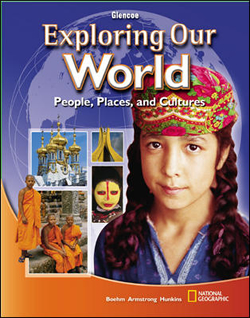Exploring Our World: People, Places, and CulturesChapter 26:
History and Cultures of East Asia and Southeast AsiaWeb Activity Lesson PlansIntroduction
In this chapter, students learned about the political and cultural development of the countries of East Asia and Southeast Asia. Governments in the region have long supported artists, writers, and architects. Religions, such as Buddhism, Confucianism, and Shinto, have also impacted the arts and architecture. Students will explore a museum web site that presents examples of the art of China and discusses its major characteristics. In doing so, students will be able to identify paintings and find answers to questions about these works. Lesson Description
Students will visit the Metropolitan Museum of Art Web site that allows viewers to sample works from major art collections. In this lesson, students will see several Chinese paintings and participate in a question-and-answer format that focuses on the major themes and features of Chinese art. Students will gain insights into the Chinese use of elegant writing as an art form and the Chinese view of the relationship between humans and nature. Instructional Objectives - The learner will be able to appreciate the techniques and skill of traditional Chinese artists in writing and painting.
- The learner will analyze several works of Chinese art to note general themes.
- The learner will be able to understand how the Chinese expressed ideas about humans and nature in their art.
Student Web Activity Answers - Chinese artists used brush, ink, and color pigments applied to paper and silk.
- Calligraphy is the art of beautiful writing. It is often used to record poetry on paintings.
- Chinese artists concentrated on scenes of nature—mountains, landscapes, animals—and human activities in homes or outdoors.
- Chinese artists and collectors placed seals on paintings to show ownership.
- Human figures were shown very small in comparison to natural features, pointing out that humans are part of nature and dependent on it.
 | 




